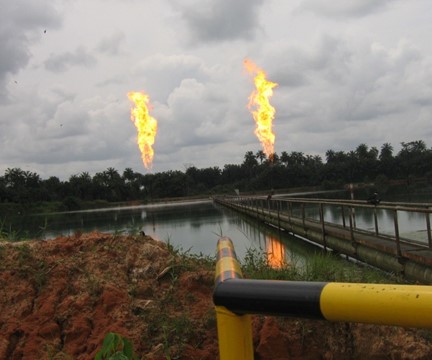Flared associated gas is a waste of a valuable energy resource, accelerating climate change through the emission of greenhouse gasses (GHG) and a health hazard. The World Bank works actively to ban this practice. With GASVESSEL, a cost-efficient and flexible solution is under way to help make use of associated gas instead of flaring it.

Gas flaring in the Niger Delta. Creative Commons license by Wikipedia user Chebyshev1983.
When petroleum crude oil is extracted and produced from onshore or offshore oil wells, raw natural gas associated with the oil is brought to the surface as well. In other words: when you drill for oil you also get gas.
In many cases of oil production only oil transportation infrastructure is available. Oil producers then have no options to make use of the available associated gas. When pipelines and other gas transportation infrastructure is missing, as is the case in many areas of the world, huge amounts of this associated gas is just flared as waste or unusable gas.
About 149 billions of cubic meters of natural gas was flared in 2016 at oil production sites around the globe according to the Global Gas Flaring Reduction Partnership (GGFR). With the GGFR the World Bank Group is taking a leadership role in gas flaring reduction initiatives.
Flaring of gas creates many real issues and problems for our planet. It not only wastes valuable sources of energy, it also harms the health of people living nearby and adds significant carbon emissions to the atmosphere. When gas is flared it releases millions of tons of CO2 to the atmosphere. Removing of 1b m3 of flared gas can reduce GHG emission by 2.7 to 3 millions of tons.
Instead of flaring associated gas it can ideally be used to generate power or be sold to consumers as raw material. However, technical and economic barriers to the development of gas transportation infrastructure impede the exploitation of associated gas. Gas pipelines or liquefaction and regasification plants are only built when there are significant amounts of gas that needs to be transported. In the case of remote and fragmented locations of oil wells there is not enough gas to support the business case for such infrastructure CAPEX investments.
For these cases the transportation of compressed gas provides a solution, which is currently being developed by the Gasvessel Project. The compressed gas solution is easy to deploy with significantly lower requirements for facilities and infrastructure, since liquefaction and regasification are not necessary.
As an alternative to generating electricity by burning coal or liquid hydrocarbons, natural gas helps to move toward a more sustainable energy path. It is the fossil fuel with the lowest carbon intensity, at half the footprint of coal at the point of combustion. Additionally, it can be the lowest-cost source of flexible electricity supply for grid-based systems with fluctuating supply and demand. By transporting associated natural gas from remote oil wells to villages and cities that currently deploy coal-based power generation, Gasvessel helps to reduce GHG emission at both ends: by removing flaring during production and by converting power generation to a more environmentally friendly source at consumer end.
